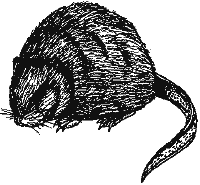The Marsh's Friend, the Muskratby Cliff GlocknerEditorial Note: We also felt that, while the article may not contain the style and polished nature of the professional writer, editing would diminish the overall "flavor" of the story. As an example I am going to describe the types of marshlands around Lake Pontchartrain which the same principal
can be applied to many of the marshes in south Louisiana during the '40s and '50s. These marshlands were bordered on the lake shore by a natural levee ranging from 2' to 10' in height above the marsh level, with an occasional break by a river, bayou or pass. The banks along these rivers, bayous and passes were also naturally elevated above the level of the marshes, preventing most of the sheet flow. This left the marshes behind the banks in essence, a saucer that held fresh water. The small bayous and some of the larger bayous were restricted by a bar (mud or sand) at the mouth which acted as a natural sill. This natural process is still evident today around the mouths of the Rigolets and Chef Menteur passes. Which made Lakes Maurepas, Pontchartrain, Borgne, the marshes of Saint Bernard and Plaquemine [parishes] some of the most productive habitat for fisheries and wildlife in the world.
Something had to keep the process going. The dying of vegetation and turning into detritus was one of these processes. Most of these sediments decompose fairly rapidly and are washed away as detritus and what is left is not compacted and not suitable for root attachment by plants, as is the popular belief. Dead grass, decomposed or not, generally is washed away by high tides during stormy seasons. Other is burned naturally by lightning fires or by fires set by trappers. There is another way these marshes were maintained and kept productive in addition to dying vegetation building sediments. This was done by a little animal called the southern muskrat. His role in nature was not only as a food source for otters, mink, coon, hawks, owls, alligators, turtles and garfish, nor only as a valuable fur-bearing animal. He also helped maintain the marshes to sustain a "no net loss." A layman's first thought when he sees a muskrat nest is that he is a destructive animal. Only through years of observing these animals in their natural habitat can one learn the truth. Muskrats reproduce very rapidly, breeding every 8 to 12 weeks. Being high on the menus of most animals and a valuable fur are ways that the muskrat is kept from overpopulating. Other ways that muskrat populations were kept in check are diseases caused by overpopulation and castration of male young by the mother. Muskrats destroying the marshes by an eat-out were a rarity. More 3-cornered grass marshes were destroyed by eat-outs caused by geese than any other way. These birds found 3-cornered grass a delicacy. They would pull so many of the red tuberous roots of the 3-cornered grasses, that they would actually turn a section of marsh into a barren mud bar. When high water covered these areas, the marsh would literally float off and leave a pond, which in turn made habitat for other fish and wildlife. One acre of marsh, with a healthy muskrat population, would have approximately 50 muskrat nests. These nests will range from a small nest by young muskrats weighing 25 lbs. of vegetation, mud and roots and up to 300 lbs. in the adult female nests. Nests are built with mud, roots and grass tops to form a slow decaying compost pile. The muskrats primarily eats the roots of the 3-cornered grass, flagging, and sawgrass from the tunnels that run beneath the roots of the grass. In turn these tunnels aerate the soil, serve as a conduit for direct root feeding from rotten vegetation that is washed along in the tunnels, and stimulates new grass growth. The muskrat only eats the red tubers and does not destroy the root system nor does he kill the plant. When marsh grasses are healthy, they will feed off of themselves receiving nutrients from the dying vegetation. Tussocks are old rat nests formed on feeding platforms, rotting logs, wood that drifted up in the marshes and partially settled in the soil. Tussocks are a massive root system of marsh plants with very little soil and is raised above the normal water level of the marsh... Due to the rapid cycle of building and abandoning muskrat nests, I believe this is how, in part, the marshes were sustained for at least the past 1500 years. This no net loss by nature's own sustainably was interrupted through the logging of cypress and creating pullboat runs, trappers' ditches cut through marshes, oil companies digging canals and pipelines, channelization and cutting of ship channels, opened the marshes to direct contact with salt water intrusion and rapid loss of nutrients and the introduction of nutria and development of marshes by man. All of these man-induced disruptions are causing the natural process to fail. Go back. [an error occurred while processing this directive] |
